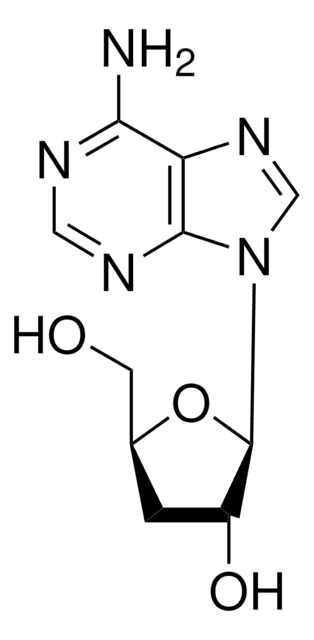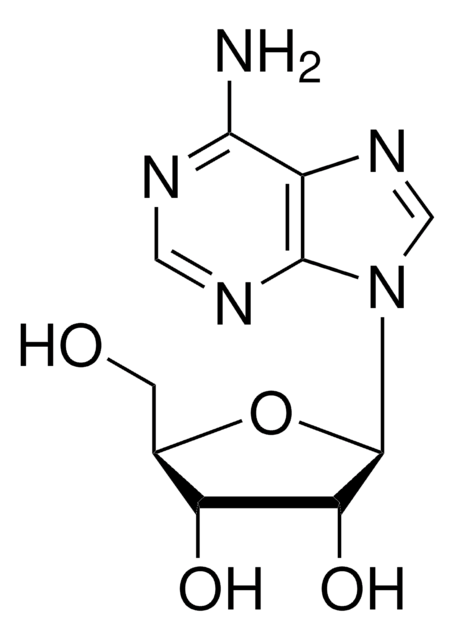C9137
Cordycepin 5′-triphosphate sodium salt
≥95%
Synonyme(s) :
3′-dATP, 3′-deoxy-ATP, 3′-Deoxyadenosine 5′-triphosphate
About This Item
Produits recommandés
Niveau de qualité
Pureté
≥95%
Forme
powder
Poids mol.
491.18 g/mol
Température de stockage
−20°C
Chaîne SMILES
[Na].Nc1ncnc2n(cnc12)C3OC(COP(O)(=O)OP(O)(=O)OP(O)(O)=O)CC3O
InChI
1S/C10H16N5O12P3.Na.H/c11-8-7-9(13-3-12-8)15(4-14-7)10-6(16)1-5(25-10)2-24-29(20,21)27-30(22,23)26-28(17,18)19;;/h3-6,10,16H,1-2H2,(H,20,21)(H,22,23)(H2,11,12,13)(H2,17,18,19);;
Clé InChI
FRGBONDYLMUOMH-UHFFFAOYSA-N
Description générale
Application
- as a transcriptional inhibitor in RNA decay assay
- to inhibit polyadenylation in HEK293T cells before harvesting for in- vitro interaction studies through co-immunoprecipitation (co-Ips)
- as a positive control in in vitro assays for polymerase inhibition
- as a precursor to produce cordycepin monophosphate
Actions biochimiques/physiologiques
Mention d'avertissement
Warning
Mentions de danger
Classification des risques
Acute Tox. 4 Oral - Carc. 2 - Eye Irrit. 2 - Skin Irrit. 2 - STOT SE 3
Organes cibles
Respiratory system
Code de la classe de stockage
11 - Combustible Solids
Classe de danger pour l'eau (WGK)
WGK 3
Équipement de protection individuelle
Eyeshields, Gloves, type P3 (EN 143) respirator cartridges
Certificats d'analyse (COA)
Recherchez un Certificats d'analyse (COA) en saisissant le numéro de lot du produit. Les numéros de lot figurent sur l'étiquette du produit après les mots "Lot" ou "Batch".
Déjà en possession de ce produit ?
Retrouvez la documentation relative aux produits que vous avez récemment achetés dans la Bibliothèque de documents.
Les clients ont également consulté
Notre équipe de scientifiques dispose d'une expérience dans tous les secteurs de la recherche, notamment en sciences de la vie, science des matériaux, synthèse chimique, chromatographie, analyse et dans de nombreux autres domaines..
Contacter notre Service technique









